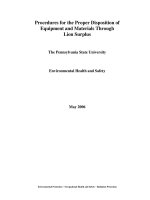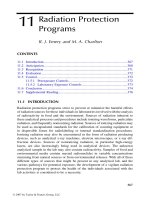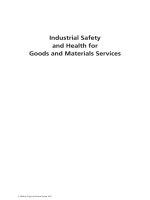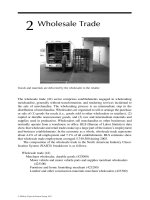Industrial Safety and Health for Goods and Materials Services - Chapter 21 pot
Bạn đang xem bản rút gọn của tài liệu. Xem và tải ngay bản đầy đủ của tài liệu tại đây (200.33 KB, 16 trang )
21
Workplace Security
and Violence
21.1 WORKPLACE SECURITY AND VIOLENCE
There is a very close alliance between security and violence. Steps taken to
provide security are often the same as those taken to prevent violence. If security
were to be adequate, the risk of violent acts would be reduced. If violent acts are
prevented the security is a success. Thus, this chapter provides a blended approach to
security and safety. Many members of the workforce in the goods and material services
sectors are in constant contact with the public and are very visible to the public.
21.1.1 BACKGROUND
Workplace violence is a serious safety and health hazard in many workplaces.
According to the Bureau of Labor Statistics (BLS), homicide is the second leading
cause of death to American workers, claiming the lives of 912 workers in 1996 and
accounting for 15% of the 6112 fatal work injuries in the United States (BLS, 1997).
Violent incidents at work also resulted in 20,438 lost workday cases in 1994
(BLS, 1996). Violence inflicte d upon employees may come from many sources,
including customers, robbers, muggers, relations, acquaintances, and coworkers to
mention a few.
Although workplace violence may appear to be random, many incidents can be
anticipated and avoided and security and preventive measures can be taken. Even
Security in a mall is much more visible as warning to those who endanger others.
ß 2008 by Taylor & Francis Group, LLC.
where a potentially violent incident occurs, a timely and appropriate response can
prevent the situation from escalating and resulting in injury or death.
21.1.2 HIGH-RISK ESTABLISHMENTS
From 1980 to 1992, the overall rate of homicide was 1.6 per 100,000 workers per
year in the retail industry, compared with a national average of 0.70 per 100,000
workers (NIOSH, 1996). Job-related homicides in retail trade accounted for 48% of
all workplace homicides in 1996 (BLS, 1997). The wide diversity within the retail
industry results in substantial variation in levels of risk of violence.
Homicides in convenience and other grocery stores, eating and drinking places,
and gasoline service stations constituted the largest share of homicides in retail
establishments (BLS, 1997). The most vulnerable appear to be liquor stores, gasoline
service stations, jewelry stores, grocery stores, convenience stores, and eating and
drinking places.
Of course, occupations such as gasoline service and garage workers, stock
handlers and baggers, sales supervisors and proprietors, and sales counter clerks
are at greatest risk.
21.2 SYSTEMATIC APPROACH TO PREVENTION
The basic recommendation is to address the five key areas of any safety and health
program. An effective approach to preventing workplace violence and insuring
security includes five key components: (1) management commitment and employee
involvement, (2) worksite analysis, (3) hazard prevention and control, (4) safety and
health training, and (5) evaluation. Using these basic elements, an employer can
devise prevention plans that are appropriate for his=her establishment, based on the
hazards and circumstances of the particular situation and address both security and
violence as an integral part of doing business.
It would be best if employers were to develop a written program for workplace
security and violence prevention. A written statement of policy serves as a touchstone
for the many separate plans, procedures, and actions required for an effective preven-
tion program. The extent to which the components of the program are in writing,
however, is less important than how effective the program is in practice. In smaller
establishments, a program can be effective without being heavily documented. As the
size of a workplace or the complexity of hazard control increases, written guidance
assumes more importance as a way to ensure clear communication and consistent
application of policies and procedures.
21.3 MANAGEMENT COMMITMENT AND EMPLOYEE
INVOLVEMENT
21.3.1 M
ANAGEMENT COMMITMENT
Management provides the motivation and resources to deal effectively with work-
place violence. The visible commitment of management to worker safety and health
ß 2008 by Taylor & Francis Group, LLC.
is an essential precondition for its success. Management can demonstrate its com-
mitment to violence prevention through the following actions:
.
Create and disseminate a policy to managers and employees that expressly
disapproves of workplace violence, verbal and nonverbal threats, and
related actions.
.
Take all violent and threatening incidents seriously, investigate them, and
take appropriate corrective action.
.
Outline a comprehensive plan for maintaining security in the workplace.
Uniformed security guards can be a part of this plan (Figure 21.1).
.
Assign responsibility and authority for the program to individuals or teams
with appropriate training and skills. This means ensuring that all managers
and employees understand their obligations.
.
Provide necessary authority and resources for staff to carry out violence
prevention responsibilities.
.
Hold managers and employees accountable for their performance. Stating
expectations means little if management does not track performance,
reward it when compe tent, and correct it when it is not.
.
Take appropriate action to ensure that managers and employees follow the
administrative controls or work practices.
.
Institute procedures for prompt reporting and tracking of violent incidents
and breaches of security that occur in and near the establishment.
.
Encourage employees to suggest ways to reduce risks and improve security,
and implement appropriate recommendations from employees and others
whenever possible.
FIGURE 21.1 Uniformed security personnel are a visible deterrent to crime and violence.
ß 2008 by Taylor & Francis Group, LLC.
.
Ensure that employees who report or experience workplace violence are not
punished or otherwise suffer discrimination.
.
Work constructively with other parti es such as landlords, lessees, local
police, and other public safety agencies to improve the security of the
premises.
21.3.2 EMPLOYEE INVOLVEMENT
Management commitment and employee involvement are complementary elem ents
of an effective safety and health program. To ensure an effective program, manage-
ment, frontline employees, and employee representatives need to work together in
the structure and operation of their violence prevention program.
Employee involvement is important for several reasons. First, frontline employees
are an important source of information about the operations of the business and the
environment in which the business operates. This may be particularly true for
employees working in wholesale, retail, and warehousing establishments where
higher level managers may not routinely be on duty. Second, inclusion of a broad
range of employees in the violence prevention program has the advantage of
harnessing a wider range of experience and insight than that of management alone.
Third, frontline workers can be very valuable problem solvers, as their personal
experience often enables them to identify practical solutions to problems and to
perceive hidden impediments to proposed changes. Finally, employees who have a
role in developing prevention programs are more likely to support and carry out
those programs.
Employees and employee representatives can be usefully involved in nearly
every aspect of a security and violence prevention program. Their involvement
may include the following:
.
Participate in surveys and offer suggestions about safety and security
issues.
.
Participate in developing and revising procedures to minimize the risk of
violence in daily business operations.
.
Assist in the security analysis of the establishment.
.
Participate in performing routine security inspections of the establishment.
.
Participate in the evaluation of prevention and control measures.
.
Participate in training current and new employees.
.
Share on-the-job experiences to help other employees recognize and
respond to escalating agitation, assaultive behavior, or criminal intent,
and discuss appropriate responses.
21.4 WORKSITE ANALYSIS
21.4.1 C
OMMON RISK FACTORS IN GOODS AND MATERIALS SECTOR
The National Institu te for Occupational Safety and Health (NIOSH) has identified a
number of factors that may increase a worker’s risk for workplace assault. Some of
ß 2008 by Taylor & Francis Group, LLC.
the common risk factors that are most often mentioned in the goods and materials
sector are as follow s:
.
Contact with the public
.
Exchange of money
.
Delivery of passengers, goods, or services
.
Working alone or in small numbers
.
Working late night or early morning hours
.
Working in high-crime areas
Employees in some estab lishments may be exposed to multiple risk factors. The
presence of a single risk factor does not necessarily indicate that the risk of violence
is a problem in a workplace. The presence, however, of multiple risk factors or a
history of workplace violence should alert an employer that the potential for work-
place violence is increased.
Research indicates that the greatest risk of work-related homicide comes from
violence inflicted by third parties such as robbers and muggers. Robbery and other
crimes were the motive in 80% of workplace homicides across all industries in 1996
(BLS, 1996).
Sexual assault is another significant occupational risk in the retail industry.
Indeed, the risk of sexual assault for women is equal to or greater than the risk of
homicide for employees in general. Sexual assault is usually not robbery related, but
may occur more often in stores with a history of robbery. These assaults occur
disproportionately at night and involve a female clerk alone in a store in the great
majority of cases.
The establishmen ts that were most attractive had large amounts of cash on hand,
an obstructed view of counters, poor outdoor lighting, and easy escape routes.
Subsequent studies have confirmed that robbers do not choose targets randomly
but, instead, consider environmental factors. The time of day also affects the
likelihood of robbery. Studies have consistently found that businesses face an
elevated risk of robbery during the nighttime hours.
21.4.2 WORKPLACE HAZARD ANALYSIS
A worksite hazard analysis involves a step-by-step, commonsensical look at the
workplace to find existing and potential hazards for workplace violence. This entails
the following steps: (1) review records and past experiences, (2) conduct an initial
worksite inspection and analysis, and (3) perform periodic safety audits.
Because the hazard analysis is the foundation for determining security weaknesses
and the violence prevention program, it is important to select carefully the persons for
this task. The employer can delegate the responsibility to one person or a team of
employees. If a large employer uses a team approach, it may wish to draw the team
members from different parts of the enterprise, such as representatives from senior
management, operations, employee assistance, security, occupational safety and
health, legal, human resources staff, and employees or union representatives. Small
establishments might assign the responsibility to a single staff member or a consultant.
ß 2008 by Taylor & Francis Group, LLC.
21.4.3 REVIEW OF RECORDS AND PAST INCIDENTS
As a starting point for the hazard analysis, the employer would review the experience
of the business over the previous 2 or 3 years. This involves collecting and exam-
ining any existing records that may shed light on the magnitude and preval ence of
the risk of workplace violence or security failures. The following questions may be
helpful in compiling information about past incidents:
.
Has your business been robbed during the last 2–3 years? Were robberies
attempted? Did injuries occur due to robberies or attempted robberies?
.
Have employees been assaulted in altercations with customers?
.
Have employees been victimized by other criminal acts at work (including
shoplifting that became assaultive)? If yes, of what kind?
.
Have employees been threatened or harassed while on duty? What was the
context of those incidents?
.
In each injury case, how serious were the injuries?
.
In each case, was a firearm involved, discharged, or threatened to be used?
Were other weapons used?
.
What part of the business was the target of the robbery or other violent
incident?
.
At what time of day did the robbery or other incident occur?
.
How many employees were on duty?
.
Were the police called to your establishment in response to the incident?
(When possible, obtain reports of the police investigation.)
.
What tasks were the employees performing at the time of the robbery or
other incident? What processes and procedures may have put employees at
risk of assault? Similarly, were there factors that may have facilitated an
outcome without injury or harm?
.
Were preventive measures already in place and used correctly?
.
Were there failures in the security system?
.
How did the victim react during the incident? Did these actions affect the
outcome of the incident in any way?
Employers with more than one store or business location could review the history of
violence at each operation. Different experiences in those stores can provide insights
into factors that can aid workplace violence. Contacting similar local businesses,
community and civic groups, and local police departments is another way to learn
about workplace violence incidents in the area. In addition, trade associations and
industry groups often provide useful information about conditions and trends in the
industry as a whole.
21.4.4 WORKPLACE SECURITY ANALYSIS
The team or coordinator could conduct a thorough initial risk assessment to identify
hazards, conditions, operations, and situations that could lead to violence. The
initial risk assessment includes a walkthrough survey to provide the data for risk
ß 2008 by Taylor & Francis Group, LLC.
identification and the development of a comprehensive workplace violence
prevention program. The assessment process includes the following:
.
Analyze incidents, including the characteristics of assailants and victims.
Give an account of what happened before and during the incident, and note
the relevant details of the situation and its outcome.
.
Identify any apparent trends in injuries or incidents relating to a particular
worksite, job title, activity, or time of day or week. The team or coordinator
should identify specific tasks that may be associated with increased risk.
.
Identify factors that may make the risk of violence more likely, such as
physical features of the building and environment, lighting deficiencies,
lack of telephones and other communication devices, areas of unsecured
access, and areas with known security problems.
.
Evaluate the effectiveness of existing security measures. Assess whether
those control measures are being properly used and whether employees
have been adequately trained in their use.
A sample list of questions that illustrates a number of questions that may be helpful
for the security analysis and can be altered to meet the needs of your business is as
follows:
.
Environmental factors
.
Do employees exchange money with the public?
.
Is the business open during evening or late-night hours?
.
Is the site located in a high-crime area?
.
Has the site experienced a robbery in the past 3 years?
.
Has the site experienced threats, harassment, or other abusive behavior
in the past 3 years?
.
Engineering control
.
Do employees have access to a telephone with an outside line?
.
Are emergency telephone numbers for law enforcement, fire and medical
services, and an internal contact person posted adjacent to the phone?
.
Is the entrance to the building easily seen from the street and free of
heavy shrub growth?
.
Is lighting bright in parking and adjacent areas?
.
Are all indoor lights working properly?
.
Are windows and views outside and inside clear of advertising or other
obstructions?
.
Is the cash register in plain view of customers and police cruisers to deter
robberies?
.
Is there a working drop safe or time access safe to minimize cash on
hand?
.
Are security cameras and mirrors placed in locations that would deter
robbers or provide greater security for employees?
.
Are there height markers on exit doors to help witnesses provide more
complete descriptions of assailants?
ß 2008 by Taylor & Francis Group, LLC.
.
Are employees protected through the use of bullet-resistant enclosures in
locations with a history of robberies or assaults in a high-crime area?
.
Administrative=work practice controls
.
Are there emergency procedures in place to address robberies and other
acts of potential violence?
.
Have employees been instructed to report suspicious persons or
activities?
.
Are employees trained in emergency response procedures for robberies
and other crimes that may occur on the premises?
.
Are employees trained in conflict resolution and in nonviolent response
to threatening situations?
.
Is cash control a key element of the establishment’s violence and robbery
prevention program?
.
Does the site have a policy limiting the number of cash registers open
during late-night hours?
.
Does the site have a policy to maintain less than $50 in the cash register?
(This may not be possible in stores that have lottery ticket sales and
payouts.)
.
Are signs posted notifying the public that limited cash, no drugs, and no
other valuables are kept on the premises?
.
Do employees work with at least one other person throughout their
shifts, or are other protective measures utilized when employees are
working alone in locations with a history of robberies or assaults in a
high-crime area?
.
Are there procedures in place to assure the safety of employees who
open and close the store?
21.4.5 PERIODIC SAFETY AUDITS
Hazard analysis is an ongoing process. A good violence prevention program will
institute a system of periodic safety audits to review workplace hazards and the
effectiveness of the control measures that have been implemented. These audits can
also evaluate the impact of other operational changes (such as new store hours, or
changes in store layout) that were adopted for other reasons but may affect the risk
of workplace violence. A safety audit is important in the aftermath of a violent
incident or other serious event for reassessing the effectiveness of the violence
prevention program.
21.5 HAZARD PREVENTION AND CONTROL
21.5.1 P
REVENTION STRATEGIES
After assessing violence hazards and the effectiveness of security, the next step is
to develop measures to provide security and protect employees from the identified
risks of injury and violent acts. Workplace security and violence prevention and
control programs include specific engineering and work practice controls to address
ß 2008 by Taylor & Francis Group, LLC.
identi fied hazards . The tool s listed in this secti on are not inte nded to be a ‘‘one-
size- fits-a ll’’ prescr iption. No single contro l will prote ct empl oyees. To provi de
effective deter rents to viol ence, the empl oyer may wish to use a combinati on of
controls in relation to the hazards identi fied throu gh the hazard analys is.
In general , a business may reduce the risk o f robber y by
.
Increasing the effor t that the perpet rator must exp end (tar get hardeni ng,
controlling access , and deterring o ffenders)
.
Increasing the risk s to the perpet rator (entr y=exit screen ing, formal survei l-
lance, and surveill ance by empl oyees and other s)
.
Reducing the rewards to the perpet rator (rem oving the targe t, ident ifying
property, and removing induce ments)
Other de terrents that may reduce the potent ial for robber y include making sure that
there are security camer as, time-re lease safes, other 24 h businesses at the location,
no easy escape route s or hiding places , an d that the store is closed durin g late -night
hours.
21.5.2 ENGINEERING C ONTROLS AND W ORKPLACE A DAPTATION
Engineer ing contr ols remov e the h azard from the wor kplace or create a barrier
between the worker and the haz ard. The follow ing physi cal changes in the workplace
can help reduce violence-r elated risk s or hazards in retail estab lishmen ts:
.
Improve visi bility as visi bility is imp ortant in preventing robber y in two
respects: First, employee s shoul d be able to see thei r surro unding s, and
second, person s outside the store, incl uding police on patrol, shoul d be
able to see into the store (Figur e 21.2). Emplo yees in the store should have
an unobstruct ed view of the street, clear of shrubbery, trees , or any form of
clutter that a criminal co uld use to hide. Signs located in wi ndows shoul d be
either low or high to allo w good visibil ity into the stor e. The custo mer service
and cash regis ter areas shoul d be visi ble from outsi de the establis hment.
Shelves should be low enough to assure g ood visibility through out the
establish ment. Convex mirrors , two-w ay mir rors, and an elevat ed vantag e
point can give employees a more complete view of their surro unding s.
.
Maintain adequate lighting within and outside the establishment to make it
less appealing to a potential robber by making detection more likely. The
parking area and the approach to the retail establishment should be well
lit during nighttime hours of operation. Exterior illumination may need
upgrading to allow employees to see what is occurring outside the store
(Figure 21.3).
.
Use fences and other structures to direct the flow of customer traffic to areas
of greater visibility.
.
Use drop safes to limit the availability of cash to robbers. Employers
using drop safes can post signs stating that the amount of cash on hand is
limited.
ß 2008 by Taylor & Francis Group, LLC.
.
Install video surveillance equipment and closed circuit TV (CCTV) to deter
robberies by increasing the risk of identification. This may include inter-
active video equipment. The video recorder for the CCTV should be secure
FIGURE 21.2 Roving patrols increase security visibility.
FIGURE 21.3 Well-designed parking lots are important security measures.
ß 2008 by Taylor & Francis Group, LLC.
and out of sight. Posting signs that surveillance equipment is in use and
placing the equipment near the cash register may increase the effectiveness
of the deterrence.
.
Put height markers on exit doors to help witnesses provide more complete
descriptions of assailants.
.
Use door detectors to alert employees when persons enter the establishment.
.
Control access to the establishment with door buzzers.
.
Use silent and personal alarms to notify police or management in the event
of a problem. To avoid angering a robber, however, an employee may need
to wait until the assailant has left before triggering an alarm.
.
Install physical barriers such as bullet-resistant enclosures with pass-
through windows between customers and employees to protect employees
from assaults and weapons in locations with a history of robberies or
assaults and located in high-crime areas.
21.5.3 ADMINISTRATIVE AND WORK PRACTICE CONTROLS
Administrative and work practice controls affect the way employees perform jobs or
specific tasks. The following examples illustrate work practices and administrative
procedures that can help prevent incidents of workplace violence:
.
Integrate violence prevention activities into daily procedures, such as
checking lighting, locks, and security cameras, to help maintain worksite
readiness.
.
Keep a minimal amount of cash in each register (e.g., $50 or less), espe-
cially during evening and late-night hours of operation. In some businesses,
transactions with large bills (over $20) can be prohibited. In situations
where this is not practical because of frequent transactions in excess of
$20, cash levels should be as low as is practical. Employees should not
carry business receipts on their person unless it is absolutely necessary.
.
Adopt proper emergency procedures for employees to use in case of a
robbery or security breach.
.
Establish systems of communication in the event of emergencies. Employees
should have access to working telephones in each work area, and emergency
telephone numbers should be posted by the phones.
.
Adopt procedures for the correct use of physical barriers, such as enclosures
and pass-through windows.
.
Increase staffing levels at night at the establishment with a history of
robbery or assaults and located in high-crime areas. It is important that
clerks be clearly visible to patrons.
.
Lock doors used for deliveries and disposal of garbage when not in use.
Also, do not unlock delivery doors until the delivery person identifies
himself or herself. Take care not to block emergency exits—doors must
open from the inside without a key to allow persons to exit in case of fire or
other emergency.
ß 2008 by Taylor & Francis Group, LLC.
.
Establish rules to ensure that empl oyees can wal k to garbage areas and
outdoo r freezer s or refrigerat ors without incre asing thei r risk o f assaul t. The
key is for empl oyees to have goo d visib ility, there by elim inating potent ial
hiding places for assai lants near these areas. In some locat ions, taking trash
out or going to outsi de freezer s during dayli ght may be safer than d oing so
at night .
.
Keep doors locked before business offi cially opens and after closing time.
Establish procedu res to assur e the securi ty of empl oyees who open and
close the business when staf fing level s may be low. In addition, the day ’s
business receipts may be a prime robber y targe t at store closing.
.
Limit or rest rict areas of custo mer a ccess, reduce the hours of operat ion, or
close portions of the estab lishmen t to limit risk.
.
Adopt safety procedu res an d poli cies for o ff-site work , such as deliverie s.
Administr ative contr ols are effective only if they are foll owed and used properly.
Regular monitor ing helps ensure that empl oyees continue to use proper wor k
practices. Giving perio dic, const ructive feedback to empl oyees helps to ensure that
they unders tand these procedu res and thei r imp ortance.
21.6 POST-INCIDENT RESPONSE
Post-inci dent respon se and evalua tion are importan t parts of an effective violence
prevention program. This invol ves develo ping stand ard operat ing procedu res for
manage ment and employee s to follow in the a ftermath of a violent inci dent. Such
procedu res may include the foll owing:
.
Assure that inju red employees recei ve prompt and appropr iate medi cal care.
This incl udes provi ding trans portation of the inju red to medi cal care.
Promp t first-aid and emergency medi cal treatmen t can min imize the harm ful
consequ ences of a viol ent incident.
.
Report the incident to the police.
.
Notify other authorities, as required by applicable laws an d regul ations.
.
Inform management about the incident.
.
Secure the premises to safeguard evidence and reduce distractions during
the post-incident response process.
.
Prepare an incident report immediately after the incident, noting details that
might be forgotten over time. A sample violence incident report can be
found in Append ix D.
.
Arrange appropriate treatment for victimized empl oyees. In addition to
physical injuries, victims and witnesses may suffer psychological trauma,
fear of returning to work, feelings of incompetence, guilt, power-
lessness, and fear of criticism by supervisors or managers. Post-incident
debriefings and counseling can reduce psychological trauma and stress
among victims and witnesses. An emerging trend is to use critical incident
stress management to provide a range or continuum of care tailored to the
individual victim or the organization’s needs.
ß 2008 by Taylor & Francis Group, LLC.
21.7 TRAINING AND EDUCATION
Training and education ensure that all staff are aware of potential security hazards
and the procedures for protecting themselves and their coworkers. Employees with
different roles in the business may need different types and levels of training.
21.7.1 GENERAL TRAINING
Employees need instruction on the specific hazards associated with their job and
worksite to help them minimize their risk of assault and injury. Such training would
include information on potential hazards identified in the establishments, and the
methods to control those hazards. Topics may include the following:
.
An overview of the potential risk of assault
.
Operational procedures, such as cash handling rules that are designed to
reduce risk
.
Proper use of security measures and engineering controls that have been
adopted in the workplace
.
Behavioral stra tegies to defuse tense situations and reduce the likelihood of
a violent outcome, such as techniques of conflict resolution and aggression
management
.
Specific instructions on how to respond to a robbery (such as the instruction
to turn over money or valuables without resistance) and how to respond to
attempted shoplifting
.
Emergency action procedures to be followed in the event of a robbery or
violent incident
Training should be conducted by persons who have a demonstrated knowledge of the
subject and should be presented in language appropriate for the individuals being
trained. Oral quizzes or written tests can ensure that the employees have actually
understood the training that they received. An employee ’s understanding also can be
verified by observing the employee at work.
The need to repeat training varies with the circumstances. Retraining should
be considered for employees who violate or forget safety measures. Similarly,
employees who are transferred to new job assignments or locations may need
training even though they may already have received some training in their former
position. Establishments with high rates of employee turnover may need to provide
training frequently.
21.7.2 TRAINING FOR SUPERVISORS,MANAGERS, AND SECURITY PERSONNEL
To recognize whether employees are following safe practices, management personnel
should undergo training comparable to that of the employees and additional training to
enable them to recognize, analyze, and establish violence prevention controls. Know-
ing how to ensure sensitive handling of traumatized employees also is an important
skill for management. Training for managers could also address any specific duties
ß 2008 by Taylor & Francis Group, LLC.
and responsibilities they have that could increase their risk of assault. Security
personnel need specific training about their roles, including the psychological com-
ponents of handling aggressive and abusive customers and ways to handle aggression
and defuse hostile situations. The team or coordinator responsible for implementation
of the program should review and evaluate annually the content, methods, and
frequency of training.
Program evaluation can involve interviewing supervisors and employees, testing
and observing employees, and reviewing responses of employees to security issues
or workplace violence incidents.
Evaluation recordkeeping good records help employers determine the severity of
the risks, evaluate the methods of hazard control, and identify training needs. An
effective violence prevention program will use records of injuries, illnesses, inci-
dents, hazards, corrective actions, and training to help identify problems and solu-
tions for a safe and healthful workplace.
Employers can tailor their recordkeeping practices to the needs of their violence
prevention program. The purpose of maintaining records is to enable the employer to
monitor its ongoing efforts, to determine if the violence prevention program is
working, and to identify ways to improve it. Employers may find the following
types of records useful for this purpose:
.
Records of employees and other injuries and illnesses at the establishment.
.
Records describing incidents involving violent acts and threats of such acts,
even if the inci dent did not involve an injury or a criminal act. Records of
events involving abuse, verbal attacks, or aggressive behavior can help
identify patterns and risks that are not evident from the smaller set of
cases that actually result in injury or crime.
.
Written hazard analyses.
.
Recommendations of police advisors, employees, or consultants.
.
Up-to-date records of actions taken to deter violence, including work
practice controls and other corrective steps.
.
Notes of safety meetings and training records.
21.8 PREVENTION PROGRAM EVALUATIONS
Violence prevention programs benefit greatly from periodic evaluation. The evalu-
ation process could involve the following:
.
Review the results of periodic safety audits.
.
Review post-incident reports. In analyz ing incidents, the employer
should pay attention not just to what went wrong, but to actions taken
by employees that avoided further harm, such as handling a shoplifting
incident in such a way as to avoid escalation to violence.
.
Examine reports and minutes from staff meetings on safety and security
issues.
.
Analyze trends and rates in illnesses, injuries, or fatalities caused by
violence relative to initial or ‘‘baseline’’ rates.
ß 2008 by Taylor & Francis Group, LLC.
.
Consult wi th empl oyees before and after maki ng job or worksite ch anges to
determin e the effectiven ess of the intervent ions.
.
Keep abreas t of new stra tegies to deal with viol ence in the retai l indus try.
Manage ment shoul d communi cate any less ons learn ed from evalua ting the work-
place violence prevent ion progra m to all empl oyees. Manage ment could discuss
changes in the program durin g regul ar meetings of the safety co mmittee, with union
representat ives, or with other employee groups .
21.9 SUMMARY
Workplace securi ty and violence has e merged as an imp ortant occupat ional safety
and health issue in many indus tries, incl uding the retail trade . The se recommend a-
tions offer a systemat ic fram ework to help an employ er prote ct empl oyees from risks
of injury and death from occupat ionally related viol ence. By addres sing workplace
violence as a prevent able haza rd, employers can develo p practical and effective
strategies to protect their employ ees from this serious risk and provi de a safe and
healthful wor kplace . The security effor t will b e imp roved by addressing workplace
violence as an issu e.
REFERENCE
National Institute for Occupational Safety and Health (NIOSH), U.S. Department of Health
and Human Services. Violence in the Workplace: Risk Factors and Prevention
Strategies (CIB 57). Washington, June 1996.
Bureau of Labor Statistics, Summary of Occupational Injuries and Illnesses in 1994,
Washington, 1996. http:==www.bls.gov.
Bureau of Labor Statistics, Occupational Fatalities in 1996, Washington, 1997, http:==www.
bls.gov.
ß 2008 by Taylor & Francis Group, LLC.
ß 2008 by Taylor & Francis Group, LLC.









